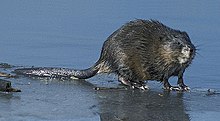Musk

Muskis a class of aromatic substances commonly used asbase notesinperfumery.They includeglandularsecretions from animals such as themusk deer,numerous plants emitting similar fragrances, and artificial substances with similarodors.[1][2]Muskwas a name originally given to a substance with a strong odor obtained from a gland of the musk deer. The substance has been used as a popular perfumefixativesince ancient times and is one of the most expensiveanimal productsin the world. The name originates from the Late Greek μόσχος 'moskhos', from PersianmushkandSanskritमुष्क muṣka (lit. 'testicle')[3]derived fromProto-Indo-Europeannounmúh₂smeaning "mouse".[1][4]The deer gland was thought to resemble ascrotum.It is applied to various plants and animals of similar smell (e.g.muskox) and has come to encompass a wide variety of aromatic substances with similar odors, despite their often differingchemical structuresand molecular shapes.
Natural musk was used extensively inperfumeryuntil the late 19th century when economic and ethical motives led to the adoption ofsynthetic musk,which is now used almost exclusively.[5]Theorganic compoundprimarily responsible for the characteristic odor of musk ismuscone.There are several ways of preparing the commercial musk, and the best method is to dry the pod by sunning and airing immediately after it is taken from the animal. Natural musk is usually packed in hermetically-sealed vessels and wooden boxes lined with tin foil because of its powerful diffusion of odor.[6]
Modern use of natural musk pods occurs intraditional Chinese medicine(TCM). TCMs in China, save for specially exempt drugs, use a synthetic version of undisclosed composition created in 1994. The process was givenState Science and Technology Progress AwardFirst Class in 2015.[7]
Natural sources
[edit]Musk deer
[edit]
The musk deer belongs to the familyMoschidaeand lives inTibet,[8]India,Nepal,Pakistan,Afghanistan,China,Siberia,Mongolia,Manchuria,KoreaandNorth Vietnam.The musk pod, apreputial glandin a pouch, or sac, under the skin of the abdomen of the male musk deer, is normally obtained by killing the male deer through traps laid in the wild. Upon drying, the reddish-brown paste inside the musk pod turns into a blackgranular materialcalled "musk grain", which is then tinctured with alcohol. The aroma of thetincturegives a pleasant odor only after it is considerablydiluted.No other natural substance has such a complex aroma associated with so many contradictory descriptions; however, it is usually described abstractly as animalistic, earthy and woody[5]or something akin to the odor of baby's skin.[9]
Musk has been a key constituent in many perfumes since its discovery, being held to give a perfume long-lasting power as a fixative. Today, the trade quantity of the natural musk is controlled by the Convention on International Trade in Endangered Species of Wild Fauna and Flora (CITES), but illegalpoachingand trading continues.[9]
-
Moschus moschiferus,Siberian musk deer
-
"Musk-cat", woodcut fromHortus Sanitatis,1491
Other animals
[edit]
Muskrat(Ondatra zibethicus), a rodent native toNorth America,has been known since the 17th century to secrete a glandular substance with a musky odor.[10]A chemical means of extracting it was discovered in the 1940s, but it did not prove commercially worthwhile.[10]
Glandular substances with musk-like odors are also obtained from themusk duck(Biziura lobata) of southernAustralia,themuskox,themusk shrew,themusk beetle(Aromia moschata), theAfrican civet(Civettictis civetta), themusk turtle(Sternotherus odoratus), theAmerican alligatorofNorth America,lynx musk,lungurionwhich, in antiquity, was highly valued, and from several other animals.
Incrocodiles,there are two pairs of musk glands, one pair situated at the corner of the jaw and the other pair in thecloaca.[11]Musk glands are also found in snakes.
Plants
[edit]Some plants such asAngelica archangelicaorAbelmoschus moschatusproduce musky-smelling macrocyclic lactone compounds. These compounds are widely used in perfumery as substitutes for animal musk or to alter the smell of a mixture of other musks.
The plant sources include the musk flower (Mimulus moschatus) of western North America, the muskwood (Olearia argophylla) of Australia, and the musk seeds (Abelmoschus moschatus) from India.
Artificial compounds
[edit]
Since obtaining the deer musk requires killing theendangered animal,nearly all musk fragrance used in perfumery today is synthetic, sometimes called "white musk". They can be divided into three major classes: aromatic nitro musks, polycyclic musk compounds, and macrocyclic musk compounds.[5]The first two groups have broad uses in industry ranging fromcosmeticstodetergents.However, the detection of the first two chemical groups in human and environmental samples as well as their carcinogenic properties initiated a public debate on the use of these compounds and a ban or reduction of their use in many regions of the world. Macrocyclic musk compounds are expected to replace them since these compounds appear to be safer.[5]
Other uses
[edit]Musk is often associated with religious significance. InIslam,musk is considered to be the most fragrant of the scents. It was widely used by theIslamic prophetMuhammadand his companions.[12]Alexander the Great[13]is also said to have perspired the odor of musk.[14][15]Popular scents in Arab Muslim tradition includejasmine,amber,musk and oud (agarwood).[16]
Musk has been used to attract wild animals, including in man-made perfume mixtures. For example, in 2018 Indian authorities used the perfumeObsessionbyCalvin Kleinto attract and thus trap a wild tiger that had attacked and killed more than a dozen humans.[17]
Musk sticks,which are artificially flavoured with a substance that is reminiscent of musk perfume, are a popularconfectioninAustralia.[citation needed]
See also
[edit]Notes
[edit]- ^ab"Merriam-Webster's Online Dictionary:musk".Merriam-Webster.Retrieved2007-04-07.
- ^Chantraine, Pierre (1990).Dictionnaire étymologique de la langue grecque.Klincksieck. p. 715.ISBN2-252-03277-4.
- ^Harper, Douglas."musk".Online Etymology Dictionary.
- ^Chantraine, Pierre (1990).Dictionnaire étymologique de la langue grecque.Klincksieck. p. 715.ISBN2-252-03277-4.
- ^abcdRimkus, Gerhard G. (Ed.); Cornelia Sommer (2004). "The Role of Musk and Musk Compounds in the Fragrance Industry".Synthetic Musk Fragrances in the Environment (Handbook of Environmental Chemistry).Springer.ISBN3-540-43706-1.
- ^"Musk: Its Pharmacological Action and Therapeutic Uses"(PDF).
- ^"Trì lai đích đại tưởng nhân công xạ hương chung hoạch quốc gia khoa kỹ tiến bộ nhất đẳng tưởng -- khoa kỹ -- nhân dân võng"[Late grand award; artificial musk finally receives State Science and Technology Progress Award First Class].scitech.people.com.cn(in Chinese).
- ^Historical Section of the Foreign Office (Great Britain) (19 June 2021)."Tibet". Handbook (No. 70).Handbooks... No.70. H M Stationery Office (1920).hdl:2027/uc1.32106000253184.
- ^abRowe, David J. (Ed.);Philip Kraft(2004). "Chapter 7. Aroma Chemicals IV: Musks".Chemistry and Technology of Flavours and Fragrances.Blackwell.ISBN0-8493-2372-X.
- ^abGroom, Nigel (1997).New Perfume Handbook.Springer. pp. 219–220.ISBN0-7514-0403-9.
- ^Wareham, D.C. (2005).Elsevier's Dictionary of Herpetological and Related Terminology.Elsevier Science.p. 129.ISBN0-444-51863-0.
- ^"Archived copy".Archivedfrom the original on 2022-11-20.Retrieved2022-04-06.
{{cite web}}:CS1 maint: archived copy as title (link) - ^Griffith, Sidney (2021)."The Narratives of" the Companions of the Cave, "Moses and His Servant, and Dhū 'l-Qarnayn in Sūrat al-Kahf".Journal of the International Qur'anic Studies Association.6:137–166.
- ^Lyttelton, Celia (February 18, 2008).The Scent Trail: An Olfactory Odyssey.Bantam.ISBN9780553815498– via Google Books.
- ^Dussauce, Hippolyte (February 18, 1868)."A Practical Guide for the Perfumer: Being a New Treatise on Perfumery the Most Favorable to Beauty Without Being Injurious to the Health, Comprising a Description of the Substances Used in Perfumery, and the Formulæ of More Than One Thousand Preparations..."H. C. Baird: London, Trübner & Company – via Google Books.
- ^Auzias, Dominique; Labourdette, Jean-Paul (November 23, 2022).QATAR (EN ANGLAIS) 2023/2024 Petit Futé.Petit Futé.ISBN9782305096186– via Google Books.
- ^"Calvin Klein's Obsession Could Be The Trick To Catching A Tiger".NPR.14 October 2018.Retrieved18 October2018.
This article incorporates text from a publication now in thepublic domain:Chisholm, Hugh,ed. (1911). "Musk".Encyclopædia Britannica.Vol. 19 (11th ed.). Cambridge University Press. p. 90.
Further reading
[edit]- Borschberg, Peter, "O comércio europeu de almíscar com a Ásia no inicio da edad moderna - The European Musk Trade with Asia in the Early Modern Period",Revista Oriente,5 (2003): 90-9.
- Borschberg, Peter, "Der asiatische Moschushandel vom frühen 15. bis zum 17. Jahrhundert", inMirabilia Asiatica,edited by J. Alves, C. Guillot and R. Ptak. Wiesbaden and Lisbon: Harrassowitz-Fundação Oriente (2003): 65–84.


